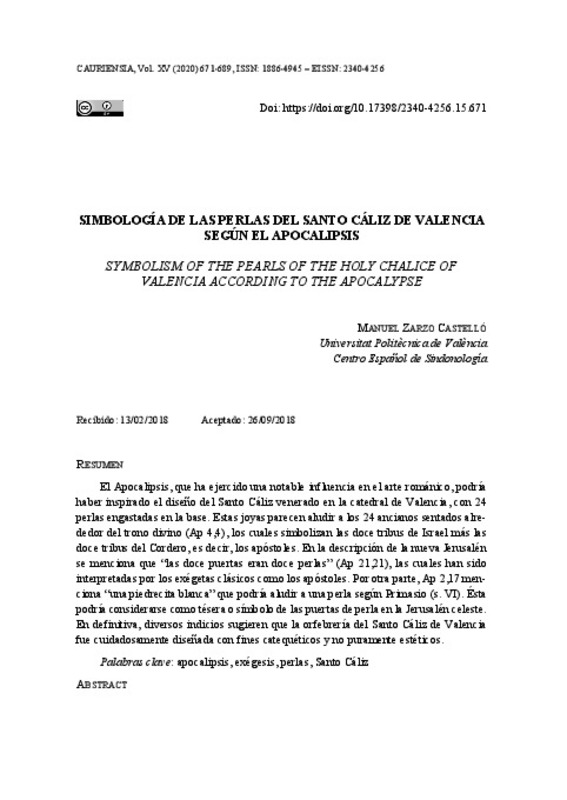JavaScript is disabled for your browser. Some features of this site may not work without it.
Buscar en RiuNet
Listar
Mi cuenta
Estadísticas
Ayuda RiuNet
Admin. UPV
Simbología de las perlas del Santo Cáliz de Valencia según el Apocalipsis
Mostrar el registro sencillo del ítem
Ficheros en el ítem
| dc.contributor.author | Zarzo Castelló, Manuel
|
es_ES |
| dc.date.accessioned | 2021-02-10T04:31:50Z | |
| dc.date.available | 2021-02-10T04:31:50Z | |
| dc.date.issued | 2020 | es_ES |
| dc.identifier.issn | 1886-4945 | es_ES |
| dc.identifier.uri | http://hdl.handle.net/10251/160991 | |
| dc.description.abstract | [ES] El Apocalipsis, que ha ejercido una notable influencia en el arte románico, podría haber inspirado el diseño del Santo Cáliz venerado en la catedral de Valencia, con 24 perlas engastadas en la base. Estas joyas parecen aludir a los 24 ancianos sentados alrededor del trono divino (Ap 4,4), los cuales simbolizan las doce tribus de Israel más las doce tribus del Cordero, es decir, los apóstoles. En la descripción de la nueva Jerusalén se menciona que ¿las doce puertas eran doce perlas¿ (Ap 21,21), las cuales han sido interpretadas por los exégetas clásicos como los apóstoles. Por otra parte, Ap 2,17 menciona ¿una piedrecita blanca¿ que podría aludir a una perla según Primasio (s. VI). Ésta podría considerarse como tésera o símbolo de las puertas de perla en la Jerusalén celeste. En definitiva, diversos indicios sugieren que la orfebrería del Santo Cáliz de Valencia fue cuidadosamente diseñada con fines catequéticos y no puramente estéticos. | es_ES |
| dc.description.abstract | [EN] The Apocalypse, which has exerted a notable influence on Romanesque art, might have inspired the design of the Holy Chalice venerated at the Cathedral of Valencia, with 24 pearls mounted at the base. These jewels seem to allude to the 24 elders sitting around the divine throne (Rev 4:4), symbolizing the twelve tribes of Israel plus the twelve tribes of the Lamb, i.e., the apostles. In the description of the new Jerusalem it is mentioned that ¿the twelve gates were twelve pearls¿ (Rev 21:21), which have been interpreted by classical exegetes as the apostles. On the other hand, Rev 2:17 mentions ¿a white pebble¿ that could refer to a pearl according to Primasius (6th c.). It might be considered as token or symbol of the pearly gates at the heavenly Jerusalem. In short, several indications suggest that the metalwork decorating the Holy Chalice of Valencia was carefully designed for catechetical and not purely aesthetic purposes. | es_ES |
| dc.language | Español | es_ES |
| dc.publisher | Instituto Teologico San Pedro de Alcantara | es_ES |
| dc.relation.ispartof | Cauriensia | es_ES |
| dc.rights | Reconocimiento (by) | es_ES |
| dc.subject | Apocalipsis | es_ES |
| dc.subject | Exégesis | es_ES |
| dc.subject | Perlas | es_ES |
| dc.subject | Santo Cáliz | es_ES |
| dc.subject | Revelation | es_ES |
| dc.subject | Exegesis | es_ES |
| dc.subject | Pearls | es_ES |
| dc.subject | Holy Chalice | es_ES |
| dc.subject.classification | ESTADISTICA E INVESTIGACION OPERATIVA | es_ES |
| dc.title | Simbología de las perlas del Santo Cáliz de Valencia según el Apocalipsis | es_ES |
| dc.title.alternative | Symbolism of the pearls of the Holy Chalice of Valencia according to the Apocalypse | es_ES |
| dc.type | Artículo | es_ES |
| dc.identifier.doi | 10.17398/2340-4256.15.671 | es_ES |
| dc.rights.accessRights | Abierto | es_ES |
| dc.contributor.affiliation | Universitat Politècnica de València. Departamento de Estadística e Investigación Operativa Aplicadas y Calidad - Departament d'Estadística i Investigació Operativa Aplicades i Qualitat | es_ES |
| dc.description.bibliographicCitation | Zarzo Castelló, M. (2020). Simbología de las perlas del Santo Cáliz de Valencia según el Apocalipsis. Cauriensia. 15:671-689. https://doi.org/10.17398/2340-4256.15.671 | es_ES |
| dc.description.accrualMethod | S | es_ES |
| dc.relation.publisherversion | https://doi.org/10.17398/2340-4256.15.671 | es_ES |
| dc.description.upvformatpinicio | 671 | es_ES |
| dc.description.upvformatpfin | 689 | es_ES |
| dc.type.version | info:eu-repo/semantics/publishedVersion | es_ES |
| dc.description.volume | 15 | es_ES |
| dc.relation.pasarela | S\419839 | es_ES |








